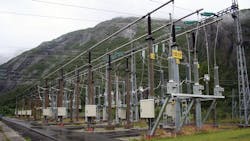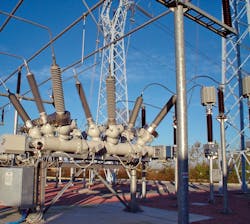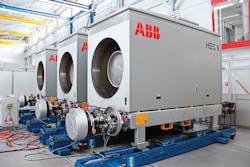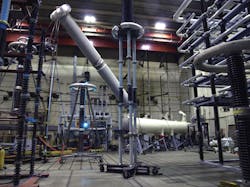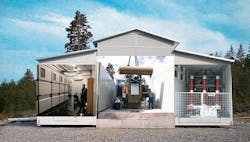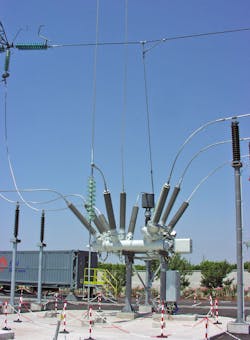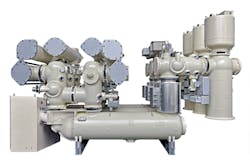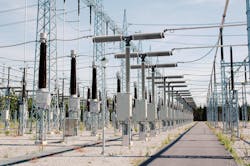Keeping Up With the Future: Latest Smart Grid Developments
Flexibility may be that elusive silver bullet everyone is looking for to address many of the electrical grid’s problems, or maybe simply being open-minded is the answer. The electric utility industry is caught between yesterday’s and tomorrow’s technology. There are some pretty remarkable applications and adaptations available today, but which of them is suitable for moving forward? Utilities are showing some reluctance to move from an established working technology to the promise of an unfamiliar technology as they deal with their limited resources.
There are many new developments, however, that can help us become more effective, efficient and creative, but it is human nature to resist change. And utilities, being typically
ultraconservative, are even more resistant to change. Utilities have the responsibility for keeping the lights on, so moving out of that comfort zone is difficult. The challenge is being able to determine what technology is a suitable solution that best fulfills the mission of providing the customer with high-quality power.
Integrating Functions
Manufacturers’ research and development efforts have been intent on enhancing sulfur hexafluoride (SF6)-based gas-insulated switchgear (GIS) technology since it was first introduced. As a result, there has been a huge reduction in size, an increase in electrical ratings and the development of the GIS substation. The smaller footprint and reduced clearances found in GIS substations have given designers a new flexibility to develop more functional substation designs.
With all the emphasis on GIS applications, it was only a matter of time before air-insulated substations (AIS) were combined with GIS to become hybrid substations. By combining the best elements of both designs, hybrids improved operating characteristics and enabled space savings that allowed smaller real-estate requirements. This concept also has proven very valuable in expanding existing substations with limited space. However, maintenance savings are, without a doubt, a key element for utilities concerned with the total cost of ownership.
SF6 breaker technology has proven to be more robust than previous designs using insulation mediums such as oil or air. Accordingly, manufacturers have produced breakers that require less time and frequency to maintain. It is not unusual for modern SF6 breakers to have a maintenance interval of 15 years or more, so why not take advantage of it?
When considering the typical disconnect switch has a maintenance cycle of three to five years, it becomes apparent change is going to happen. The first device to address this issue is thedisconnecting circuit breaker (DCB). ABB integrated the functions of a circuit breaker with the functions of a disconnect switch into one apparatus in a single housing. In 2000, Swedish utility Svenska Kraftnat installed the world’s first DCB in one of its key high-voltage substations.
The DCBuses the same contacts in the SF6 environment for the breaker and disconnect function. The device has three positions: open, closed and disconnected. The disconnected position mechanically blocks the contacts in the open position for personnel safety. The contacts are locked and the DCB’s grounding switch is closed to address the traditional visible open gap of the conventional AIS design.
In keeping with this philosophy of simplification, ABB added fiber-optic current sensors (FOCS) to the DCB, replacing the conventional style of current transformers. The FOCS use the Faraday effect to measure current with a fiber-optic loop placed around the conductor. FOCS have an additional benefit in that all data collected is in a digital format, reducing the need for secondary cabling. All of this simplification not only improves the maintenance cycle but reduces the number of components in the typical substation. And, with fewer parts overall, reliability increases.
This approach cleans up the general design, reduces labor and increases the aggregate availability. Separate disconnecting switches are a fundamental concept for engineers and maintenance personnel who have been schooled in the universal use of isolating switches. They are considered an essential part of the substation, but a disruptive technology such as the DCB can be unsettling. However, once the DCB’s strengths and benefits are more familiar, configurations will be revised to be more cost-effective. Designs taking advantage of the DCB technology reduce redundancy. Several European utilities already have begun such an undertaking and refurbished older substations with DCBs, and have reported massive space savings.
Plug and Play
For many years, utilities have predefined specific substation designs in an effort to streamline their substation work process. It has proven to be a valuable tool in saving engineering time, limiting common errors and reducing equipment costs, but this approach is not flexible and making changes disrupts everything. With the introduction of tools like the DCB, GIS and hybrids, it is now a different ball game.
These advancements give the substation engineer the ability to use the plug-and-play style so common in the rest of the high-tech world. Plug and play is a powerful process made possible because of a simple approach used by other industries: modules. For years, modular construction has been a big part of building airplanes, ships and automobiles, and now it is catching on for substations. These modules are defined as a pre-engineered package of substation components and their interconnections.
The modules are broken down into the smallest subassembly on which a substation is built. The goal of modular construction is to reduce engineering time by standardizing the design, avoiding design errors, simplifying documentation and lowering lead times by using off-the-shelf designs. This approach is a powerful instrument for addressing cost issues, expedited schedules, emergency construction and a reduced workforce brought about as baby boomers retire and leave the industry.
In 1999, ABB came up with an interesting approach to modular designs for the new millennium with its PASS (Plug And Switch System) scheme. What makes PASS interesting is the fact it is a hybrid switchgear that combines traditional AIS components with advanced GIS components. The result is a compact design, which includes all of the elements normally associated with a full bay of switchgear integrated into a single module that has been assembled and tested in the factory. In effect, it gives designers the ability to use the standardized approach in a customized manner. The designer can have the maximum design flexibility while still being able to take advantage of benefits found in the modular approach.
Substations in a Box
With all the customer concerns over the environment and aesthetics, permitting takes an inordinate amount of time to get approvals for new facilities. Taking building blocks, such as PASS and GIS modules, and placing them inside prefabricated metal housings creates an attractive package that the community often fails to notice is a substation.
These prefab GIS substation installations consist of modules that are designed, assembled and tested in a factory environment, and then placed in a metal housing and shipped to the site. Once on site, the assembly is offloaded onto its foundation, tested and commissioned. Instead of taking the usual months required to do these tasks, the prefab methodology takes only a week or so for installation.
Manufacturers report that these prefabricated substations have an amazing footprint of just 10% to 20% of that of a conventional AIS substation, making them ideal for tight locations in congested urban population centers. In addition, by having the components located inside the housing, they are protected from weather and pollution, which also has the positive effect of reducing maintenance labor.
Pushing Boundaries
The SF6 technology that utilities are so attached to has made constant advancements since its first introduction to the industry. One side of the SF6 equation has been pushed to incredible voltage and current levels. In 2011, Power Grid Corp. of India announced a new ultrahigh-voltage (UHV) 1200-kV ac transmission project.
The UHV transmission system used the world’s first 1200-kV SF6 circuit breaker, developed by Siemens. Power Grid Corp. of India reported the UHV 1200-kV line would have twice the capacity of an 800-kV ac transmission line (roughly 8000 MW). This would allow them to transfer large blocks of power from their remote generation facilities to load centers by interconnecting regional grids more efficiently.
In addition to the UHV voltage levels, the technology moved into some extremely high current interruption levels, too. The generator’s main circuit breaker is considered to be the behemoth of the circuit breaker world. These devices experience tremendous forces under short-circuit conditions located next to the generator. The generator creates conditions that could be hazardous to the long-term health of a standard circuit breaker, which requires that vendors develop sophisticated, reliable technology.
In 2012, ABB took SF6 generator main circuit breakers to another level with the introduction of a breaker capable of being installed on an 1800-MW generator. This breaker has the ability to interrupt a fault current of 250 kA. This is huge considering the implications of interrupting fault currents of that magnitude so up close and personal to the generator. Induced magnetic forces alone can cause solid steel shafts to bend at that rating.
Some Assembly Required or Not
While bigger may be considered better, smaller has been chalking up impressive advantages on the other side of the SF6 equation. Maturing SF6 switchgear technology has produced an interesting phenomenon: increased ratings, reduced physical size. Smaller modules reduced the amount of SF6 gas on board, which is helping utilities to meet the goals of the Kyoto protocol. The protocol targeted the reduction of all greenhouse gas emissions worldwide. Manufacturers such as ABB, Alstom and Siemens report that state-of-the-art GIS devices use about 40% less SF6 than previous generations, which is what the proponents of protocol are supporting.
Another advantage of reducing the size came from being able to ship an entire module on one truck — fewer trucks equals lower shipping costs. In addition, less field assembly work results in huge labor savings. And, if that was not enough, the compactness made the urban substations more attractive to the community.
Compact GIS facilities can be hidden inside buildings, underground and many other places that lend themselves to more aesthetic appeal. By being installed closer to the load center, losses associated with remote substations are reduced, which makes them attractive to the utility, too.
Expanding the Grid
With the development of voltage source converter (VSC) technology, the industry has the ability to build an HVDC transmission system, but it needs switchgear suitable for the deployment. The main problem is that existing mechanical HVDC breakers are capable of interrupting HVDC currents, but they are too slow to fulfill the requirements of a reliable HVDC grid.
Semiconductor HVDC circuit breakers are fast enough to overcome operating speed limitations, but they generate large transfer losses, typically 30% of the losses of a VSC station. However, the relatively low impedance found in HVDC grids is a challenge when a short-circuit fault occurs. Therefore, fast and reliable HVDC breakers are needed to isolate faults and avoid a collapse of the common HVDC grid. In order to minimize disturbances in converter operation, particularly the operation of stations not connected to the faulted circuit, it is necessary to clear the fault within a few milliseconds. In Europe, there is a lot of interest in developing such an HVDC grid, both on shore and offshore, to strengthen the ac grid and to bring renewable generation to the load centers.
Germany has presented a proposal to incorporate an HVDC grid onto the ac grid, too (see “Connecting the Dots” in T&D World’s HVDC supplement, April 2012) with its
Netzentwicklungsplan. To enable such an HVDC grid, ABB has developed a hybrid HVDC breaker that combines the best features of the mechanical and semiconductor designs. The hybrid breaker’s fast fault handling (less than 5 ms) will enable the converter stations to operate as stand-alone static compensations units to stabilize voltage and increase transmission capacity in the ac grid during fault clearance. The HVDC hybrid breaker has been tested at voltages up to 320 kV and rated currents up to 2 kA. Application of this new switchgear concept will allow the development of HVDC transmission grids where power flow can be maintained, even if there is a fault on one of the lines.
Changing the Grid
The industry has progressed well beyond what anyone would have expected when it was young. Switchgear has become so much more than just a switching device. It is an integral part of the grid. With utilities taking advantage of advancements in the technology to design and build more efficient substations, switchgear is playing a huge role to improve reliability, supply higher ratings, make footprints smaller and reduce maintenance labor.
Where is the industry going next? Well, that is hard to say. With all of the research and development taking place, the future will be exciting, for sure, but everyone will have to wait and see what develops. The advancements in switchgear technology are making certain it is not going to be business as usual. Each new improvement impacts the next change. One thing is definite: This is an electrifying time for an electrifying industry.
Sidebar: Monitoring Versus NERC-CIP
The electrical power grid is highly dependent upon the health and reliability of its components, but monitoring the condition of these components has always been a challenge. In fact, it has gotten more challenging with the North American Electric Reliability Corp.’s Critical Infrastructure Protection (NERC-CIP) program. NERC-CIP seeks to improve physical and cyber security on the bulk power system and has some significant requirements for schemes used on utility infrastructure.
Rochester Gas and Electric (RG&E) has taken an interesting approach to monitor circuit breakers on its system in an effort to improve the reliability of its 362-kV transmission connection within the New York Power Authority. RG&E decided to equip some of its circuit breakers with real-time remote-condition monitoring. The monitoring system also will allow for proactive maintenance practices to be instituted.
RG&E has initially selected 18 of its 121-kV and 362-kV PMI breakers to be equipped with a wireless monitor system. The system is ABB’s asset optimization (AO) system, which monitors a myriad of breaker status and performance parameters. Data from each breaker is gathered by a special onboard system that has been paired with a cellular communicator. This was felt to be the most cost-effective means of delivering data to a central office, especially from substations lacking an existing network structure.
The onboard monitoring approach was especially interesting, because the units and their wireless communications architecture function independently from RG&E’s bulk power operating and control system. This separation exempts the monitoring system from NERC-CIP’s requirements. RG&E reports the accumulated data is processed at its central office using ABB’s AO system. The AO system delivers real-time, independently accessible data to detect circuit breaker health and performance conditions before a failure occurs.
The AO system also helps RG&E diagnose circuit breaker problems, offers corrective recommendations and provides storage for long-term data. The system’s alerts vary in complexity, from identifying status changes in an intelligent device to identifying abnormal conditions. This system gives utilities a distinct advantage in asset management without impacting critical NERC-CIP security measures.
Sidebar: Improving Dielectric Technology
When asked what our industry is doing to protect the environment, renewable generation (including wind and solar) is at the forefront of most people’s thoughts, but there is a great deal more taking place behind the scenes that isn’t headline-grabbing. Manufacturers are producing products that have the lowest environmental footprint possible for our grid’s infrastructure and switchgear is leading the pack.
The ability to manage the arc caused by interrupting a current has been a story of steady technological improvement. We started out using some pretty primitive devices with all manner of insulating mediums. Dielectric insulation improvement has been an interesting quest that has included the use of mineral oil, various gases, vacuums and solid-state devices. Manufacturers have committed a great deal of time and resources to develop an insulating medium that is eco-efficient and still able to perform the arc quenching needed by the interrupter.
One of the best mediums in use today is the inert gas known as sulfur hexafluoride (SF6). It has excellent dielectric insulation and arc-extinguishing properties, which has led SF6 to be used extensively in the electrical industry for gas-insulated switchgear. SF6 gas has a much higher dielectric strength than other insulation media, which has allowed manufacturers to significantly reduce product footprint and design more compact equipment. Reducing the size of the equipment reduces land requirements, uses less SF6 gas and reduces energy consumption, but SF6 gas has a high global warming potential (GWP).
GWP is the relative measure of how much heat greenhouse gas traps in the atmosphere compared to the same mass of carbon dioxide (CO2). The 20-year GWP of SF6 is 16,300 times that of CO2, which has led manufacturers to develop switchgear with very robust gas systems designed to prevent leakage of the SF6 gas into the atmosphere. These leakproof designs have been so successful that a CIGRÉ report estimated that electrical system SF6 emissions accounted for about 0.1% of the total GWP of gases in the atmosphere.
This is a good track record, but environmental concerns require the industry to develop viable alternatives to SF6. One of the most promising replacement agents is CO2 itself, according to ABB. It has very good insulating and arc-extinguishing characteristics along with an excellent GWP. As a result, ABB has developed the world’s first high-voltage circuit breaker using CO2. The breaker is a live tank model designated the LTA. ABB estimates that by substituting CO2 for SF6 as an insulating medium, the LTA breaker has the potential to reduce CO2 emissions by about ten tons, or 18%, over its 30-year lifetime than its predecessor, the LTB breaker.
Testing has proven the breaker is capable of interrupting currents up to 31.5 kA, but utilities require field testing to prove concepts. Therefore, ABB and Vattenfall, one of the largest generators of electricity in Europe, installed the first LTA circuit breaker at one of Vattenfall’s 132-kV Swedish substations in 2010. The breaker was part of the pilot project for field testing of the new CO2 device. ABB reports that for the first part of the project the LTA breaker was used for capacitor switching. It was then used as a line circuit breaker for the remainder of the time. It has approximately 400 breaking operations for the time frame and has exceeded all expectations.
In 2012, this new breaker technology was introduced to the industry at the CIGRÉ technical exhibit held in Paris. The CO2 circuit breaker is another tool that has been added to the designer’s tool box to improve the eco-efficiency of the grid.
About the Author
Gene Wolf
Technical Editor
Gene Wolf has been designing and building substations and other high technology facilities for over 32 years. He received his BSEE from Wichita State University. He received his MSEE from New Mexico State University. He is a registered professional engineer in the states of California and New Mexico. He started his career as a substation engineer for Kansas Gas and Electric, retired as the Principal Engineer of Stations for Public Service Company of New Mexico recently, and founded Lone Wolf Engineering, LLC an engineering consulting company.
Gene is widely recognized as a technical leader in the electric power industry. Gene is a fellow of the IEEE. He is the former Chairman of the IEEE PES T&D Committee. He has held the position of the Chairman of the HVDC & FACTS Subcommittee and membership in many T&D working groups. Gene is also active in renewable energy. He sponsored the formation of the “Integration of Renewable Energy into the Transmission & Distribution Grids” subcommittee and the “Intelligent Grid Transmission and Distribution” subcommittee within the Transmission and Distribution committee.
